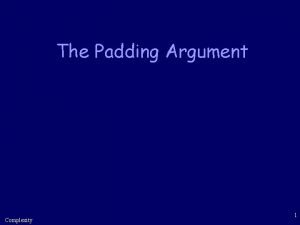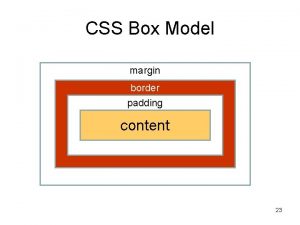The Padding Argument Complexity 1 Motivation ScalingUp Complexity













- Slides: 13

The Padding Argument Complexity 1

Motivation: Scaling-Up Complexity Claims We have: space can be simulated by… + non-determinism space + determinism We want: space + non-determinism Complexity can be simulated by… space + determinism 2

Formally si(n) can be computed with space si(n) Claim: For any two space constructible functions s 1(n), s 2(n) logn, f(n) n: simulation overhead NSPACE(s 1(n)) SPACE(s 2(n)) NSPACE(s 1(f(n))) SPACE(s 2(f(n))) E. g NSPACE(n) SPACE(n 2) NSPACE(n 2) SPACE(n 4) Complexity 3

Idea n . . . f(n) . . . 0 . . . . n . . . space: s 1(. ) in the size of its input NTM space: DTM O(s 1(f(n))) space: O(s 2(f(n))) 0 Complexity 4

Padding argument • Let L NPSPACE(s 1(f(n))) • There is a 3 -Tape-NTM ML: |x| Input babba ����������� Work ����������������� Complexity O(s 1(f(|x|))) 5

Padding argument • Let L’ = { x 0 f(|x|)-|x| | x L } • We’ll show a NTM ML’ which decides L’ in the same number of cells as ML. f(|x|) Input babba 0000000000000000 ��� Work ����������������� Complexity O(s 1(f(|x|)) 6

Padding argument – ML’ In O(log(f(|x|)) space 1. Count backwards the number of 0’s and check there are f(|x|)-|x| such. in O(s (f(|x|))) space 1 2. Run ML on x. f(|x|) Input babba 0000000000000000 ��� Work ����������������� Complexity O(s 1(f(|x|))) 7

Padding argument Total space: O(s 1(f(|x|))) f(|x|) Input babba 0000000000000000 ��� Work ����������������� O(s 1(f(|x|))) Complexity 8

Padding Argument • • Complexity We started with L NSPACE(s 1(f(n))) We showed: L’ NSPACE(s 1(n)) Thus, L’ SPACE(s 2(n)) Using the DTM for L’ we’ll construct a DTM for L, which will work in O(s 2(f(n))) space. 9

Padding Argument • The DTM for L’ will simulate the DTM for L when working on its input concatenated with zeros Input babba ��� 000000000000 Complexity 10

Padding Argument • When the input head leaves the input part, just pretend it encounters 0 s. • keeping track after the simulated position takes O(log(f(|x|))) space. • Thus our machine uses O(s 2(f(|x|))) space. • NSPACE(s 1(f(n))) SPACE(s 2(f(n))) Complexity 11

Savitch: Generalized Version Theorem (Savitch): S(n) ≥ log(n) NSPACE(S(n)) SPACE(S(n)2) Proof: We proved NL SPACE(log 2 n). The theorem follows from the padding argument. Complexity 12

Corollary: PSPACE = NPSPACE Proof: Clearly, PSPACE NPSPACE. By Savitch’s theorem, NPSPACE. Complexity 13
 Padding argument
Padding argument Bidai rigid
Bidai rigid Margin border css
Margin border css Padding bidai
Padding bidai For loop space complexity
For loop space complexity Teleological argument vs ontological argument
Teleological argument vs ontological argument V cc cc
V cc cc Voi kéo gỗ như thế nào
Voi kéo gỗ như thế nào Thẻ vin
Thẻ vin Thơ thất ngôn tứ tuyệt đường luật
Thơ thất ngôn tứ tuyệt đường luật Các châu lục và đại dương trên thế giới
Các châu lục và đại dương trên thế giới Khi nào hổ mẹ dạy hổ con săn mồi
Khi nào hổ mẹ dạy hổ con săn mồi Từ ngữ thể hiện lòng nhân hậu
Từ ngữ thể hiện lòng nhân hậu Diễn thế sinh thái là
Diễn thế sinh thái là
























